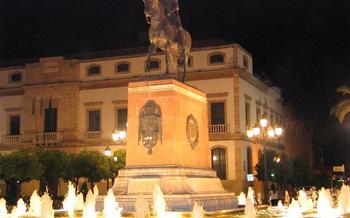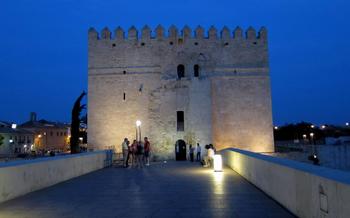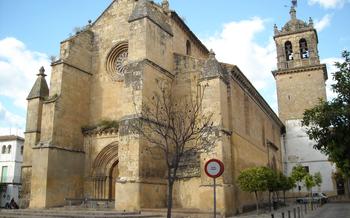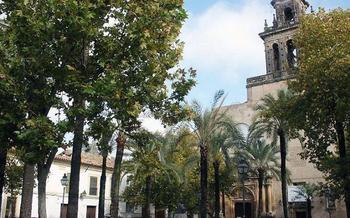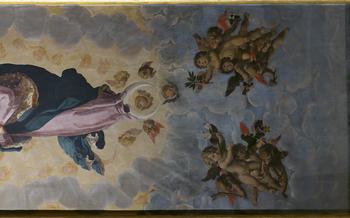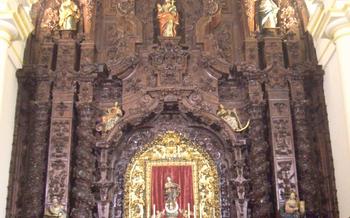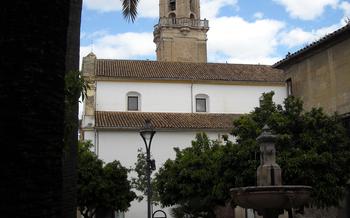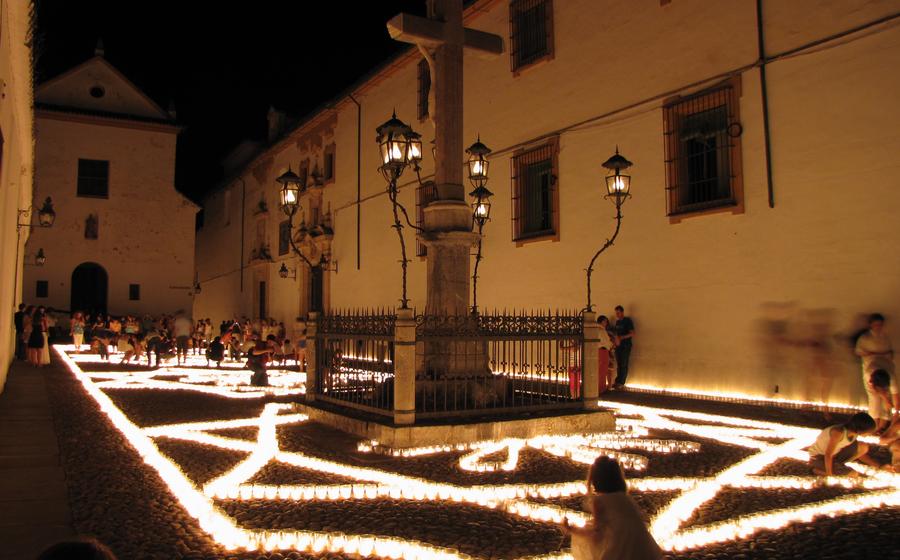
Cristo de los Faroles
- Historical Significance
- Location and Accessibility
- Architecture and Design
- Religious Significance
- Cultural Importance
- Local Legends and Stories
- Restoration and Conservation
- Photography and Videography
- Accessibility for Visitors with Disabilities:
- Souvenirs and Merchandise
- Local Festivals and Events
- Nearby Attractions and Activities
- Local Cuisine and Restaurants
- Insider Tip:
Historical Significance
At the heart of Córdoba, nestled within the ancient walls of the Jewish Quarter, lies a revered crucifix known as the Cristo de los Faroles. Its story begins in the 14th century, a time of profound religious devotion and artistic expression in Spain. The exact origins of the crucifix remain shrouded in mystery, but it is believed to have been commissioned by a wealthy family as an act of faith and piety. Over the centuries, the Cristo de los Faroles has become an integral part of Córdoba's cultural and religious identity, attracting pilgrims, worshippers, and art enthusiasts from around the world. It stands as a testament to the city's rich history, embodying the deep-rooted Catholic traditions that have shaped its soul.
Location and Accessibility
The Cristo de los Faroles is situated in the heart of Córdoba's historic center, within the ancient Jewish quarter. It resides in a small square known as Plaza del Potro, a charming and picturesque spot surrounded by whitewashed buildings, traditional patios, and narrow cobbled streets. The square is a popular gathering place for locals and tourists alike, offering a glimpse into Córdoba's rich history and vibrant atmosphere.
To reach the Cristo de los Faroles, visitors can easily walk from the city's main attractions, such as the Mezquita-Catedral or the Alcázar de los Reyes Cristianos. The square is also well-connected by public transportation, with several bus lines stopping nearby. For those arriving by car, limited parking is available in the surrounding streets, but it's recommended to explore the area on foot to fully appreciate its charm.
Architecture and Design
The Cristo de los Faroles showcases a unique blend of Gothic and Renaissance architectural styles, reflecting the artistic transition during the 14th century. Its Gothic roots are evident in the pointed arches, ribbed vaults, and intricate tracery of the surrounding chapel. However, the Renaissance influence is prominent in the naturalistic depiction of the crucified Christ, capturing the emotional depth and realism characteristic of the period.
The crucifix itself is carved from a single block of wood, demonstrating the exceptional craftsmanship of its creators. The life-size figure of Christ, with its expressive facial features and meticulously rendered drapery, evokes a profound sense of pathos and devotion. The detailed carvings of the surrounding angels, cherubs, and decorative elements further enhance the artistic significance of the artwork.
The symbolism associated with the Cristo de los Faroles is rich and multifaceted. The lanterns that illuminate the crucifix represent the light of Christ, guiding and protecting the faithful. The intricate carvings of grapes and vine leaves symbolize the Eucharist, while the crown of thorns and the nails recall the Passion of Christ. These elements combine to create a powerful visual narrative that speaks to the religious and cultural significance of the crucifix.
Over the centuries, the Cristo de los Faroles has undergone several restoration and conservation efforts to preserve its artistic integrity. These efforts have involved cleaning, repairing, and stabilizing the wooden structure, as well as restoring the original polychromy and gilding. The ongoing dedication to its preservation ensures that this remarkable artwork continues to inspire and captivate visitors for generations to come.
Religious Significance
The Cristo de los Faroles holds immense religious significance for the Catholic community in Córdoba. It is revered as a symbol of faith and devotion, attracting pilgrims and worshippers from far and wide. The crucifix is a central figure in local religious traditions and practices, deeply embedded in the cultural fabric of the city.
During Holy Week, the Cristo de los Faroles takes center stage in the city's elaborate processions. Thousands of devotees line the streets to witness the solemn procession, carrying the crucifix through the historic heart of Córdoba. The atmosphere is one of reverence and devotion as the faithful pay homage to the sacred image.
The Cristo de los Faroles is also associated with several religious ceremonies and events throughout the year. On Good Friday, the crucifix is taken down from its pedestal and placed in a horizontal position, symbolizing the crucifixion of Jesus Christ. This poignant ceremony is followed by a candlelit vigil and prayers.
The Cristo de los Faroles serves as a reminder of the city's rich religious heritage and continues to inspire faith and devotion among the people of Córdoba. Its presence in the city is a testament to the deep spiritual connection between the people and their religious beliefs.
Cultural Importance
The Cristo de los Faroles holds immense cultural significance for the city of Córdoba. It has become an integral part of the local folklore, art, and literature. The crucifix has inspired numerous works of art, including paintings, sculptures, and poetry. It has also been featured in local festivals and celebrations, such as the annual Fiesta de la Cruz, where it is paraded through the streets of Córdoba. The Cristo de los Faroles has become a symbol of Córdoba's rich cultural heritage and a source of pride for its citizens. Its enduring presence in the city's landscape and its deep connection to the local community make it a truly remarkable cultural icon.
Local Legends and Stories
The Cristo de los Faroles is not just a sacred icon in Córdoba; it is also a source of captivating local legends and stories. These tales have been passed down through generations, shaping the local perceptions and beliefs about the crucifix. One of the most famous legends tells the story of a young woman named María who was falsely accused of a crime. Desperate for help, she prayed to the Cristo de los Faroles, promising to light a candle every day if she was saved. Miraculously, her innocence was proven, and she kept her promise, lighting a candle at the crucifix every day for the rest of her life.
Another legend recounts the miraculous intervention of the Cristo de los Faroles during a great plague that ravaged Córdoba in the 16th century. As the city was gripped by despair and death, the people turned to the crucifix for solace and protection. Miraculously, the plague subsided, and the Cristo de los Faroles was credited with saving the city. These legends and stories have deeply intertwined the Cristo de los Faroles with the cultural fabric of Córdoba, making it a symbol of hope, faith, and divine protection.
Restoration and Conservation
The Cristo de los Faroles has undergone several restoration and conservation efforts throughout its history to preserve its artistic and religious significance. In the 19th century, the crucifix was restored by the renowned artist and sculptor Manuel Garnelo, who repaired damages caused by age and weathering. In the 20th century, further restoration work was carried out to address structural issues and enhance the overall appearance of the artwork.
The restoration process involved meticulous cleaning and conservation techniques to remove dirt, grime, and any signs of deterioration. Experts carefully assessed the condition of the wood, metal, and paint, using specialized techniques to stabilize and reinforce the structure. The original polychrome finish was carefully restored, preserving the vibrant colors and intricate details of the crucifix.
Ongoing conservation efforts are crucial to ensure the long-term preservation of the Cristo de los Faroles. Regular monitoring and maintenance are carried out to identify and address any potential issues. The use of advanced technology, such as 3D scanning and digital imaging, allows conservators to document and analyze the condition of the artwork, aiding in the development of effective conservation strategies.
Photography and Videography
Photography and videography are permitted at the Cristo de los Faroles, offering visitors the opportunity to capture the beauty and significance of this revered crucifix. However, it is important to be respectful of the religious nature of the site and to adhere to any guidelines or restrictions that may be in place.
When taking photographs or videos, visitors are kindly requested to avoid using flash or tripods, as these can be disruptive to other visitors and may damage the artwork. It is also important to maintain a respectful distance from the crucifix and to avoid blocking the view of others.
For professional photographers or videographers seeking to capture the Cristo de los Faroles in a more comprehensive manner, it is advisable to obtain prior permission from the church authorities. This will ensure that your work does not interfere with religious services or other events taking place at the site.
The best time to photograph the Cristo de los Faroles is during the early morning or late afternoon, when the natural light provides a warm and flattering illumination. This is particularly important for capturing the intricate details and symbolism of the crucifix.
By following these guidelines and respecting the sacred nature of the site, visitors can capture memorable images and videos of the Cristo de los Faroles, preserving their own personal connection to this iconic artwork.
Accessibility for Visitors with Disabilities:
The Cristo de los Faroles is committed to ensuring accessibility for visitors with disabilities. The site features ramps and elevators to facilitate movement throughout the premises. Wheelchair-accessible areas allow visitors to navigate the site and enjoy the crucifix up close. Visitors with disabilities can request assistance or make special arrangements by contacting the site's administration in advance. The staff is dedicated to providing a welcoming and inclusive environment for all visitors, ensuring that everyone can experience the cultural and religious significance of the Cristo de los Faroles.
Souvenirs and Merchandise
Visitors eager to take home a piece of their Cristo de los Faroles experience will find a range of souvenirs and merchandise available. The on-site gift shop offers a curated selection of items, including replicas of the crucifix in various sizes, postcards featuring stunning photographs, and religious objects such as rosaries and medals. For those seeking unique or meaningful mementos, consider purchasing a handcrafted replica of the Cristo de los Faroles, meticulously crafted by local artisans using traditional techniques. These replicas, often made from wood or metal, capture the intricate details and symbolism of the original artwork, serving as a lasting reminder of your visit to Córdoba.
Local Festivals and Events
The Cristo de los Faroles is deeply ingrained in the cultural fabric of Córdoba, and its significance extends beyond its religious and historical importance. Throughout the year, several local festivals and events celebrate or feature the crucifix, offering visitors a chance to immerse themselves in the city's rich traditions.
One of the most notable events is the annual Feast of the Cristo de los Faroles, held every May. During this festival, the crucifix is carried in a grand procession through the streets of Córdoba, accompanied by music, dancing, and colorful displays. Devotees and spectators alike gather to pay homage to the Cristo de los Faroles and participate in the vibrant festivities.
Another significant event is Holy Week (Semana Santa), a solemn and reflective period in the Christian calendar. During this time, the Cristo de los Faroles becomes a central figure in the city's religious processions, which showcase elaborate floats and penitents dressed in traditional robes. The atmosphere is both somber and awe-inspiring, as the community comes together to commemorate the crucifixion and resurrection of Jesus Christ.
Visitors to Córdoba during these festivals can expect to witness a spectacle of colors, sounds, and emotions that showcase the city's deep-rooted devotion to the Cristo de los Faroles. Participating in these events offers a unique opportunity to connect with the local culture, experience the vibrant traditions of Córdoba, and gain a deeper understanding of the city's spiritual heritage.
Nearby Attractions and Activities
The Cristo de los Faroles is conveniently located near several other notable attractions in Córdoba. Visitors can easily combine their visit to the crucifix with a stroll through the historic Jewish Quarter, exploring its narrow streets, synagogues, and museums. The nearby Alcázar de los Reyes Cristianos, a former palace and fortress, offers a glimpse into Córdoba's rich history and architecture.
For art enthusiasts, the Museo de Bellas Artes de Córdoba, just a short walk away, houses an impressive collection of paintings, sculptures, and drawings from the Middle Ages to the present day. The renowned Mezquita-Catedral de Córdoba, a UNESCO World Heritage Site, is also within easy reach, showcasing a unique blend of Islamic and Christian architectural elements.
To immerse yourself in the local culture, head to the vibrant Mercado de la Corredera, a bustling market square filled with stalls selling fresh produce, local delicacies, and traditional crafts. The nearby Plaza de las Tendillas, the city's main square, offers a lively atmosphere with cafes, shops, and street performers.
By combining your visit to the Cristo de los Faroles with these nearby attractions, you can create a comprehensive and enriching itinerary that showcases the diverse cultural and historical offerings of Córdoba.
Local Cuisine and Restaurants
After exploring the historical and cultural significance of the Cristo de los Faroles, visitors can indulge in the culinary delights of Córdoba. In the vicinity of the crucifix, a plethora of local restaurants and eateries await, offering a tantalizing array of traditional Spanish cuisine and regional specialties.
For an authentic taste of Córdoba, try the salmorejo cordobés, a chilled tomato soup garnished with hard-boiled eggs and croutons, or the flamenquín, a deep-fried pork loin wrapped in Serrano ham.
Seafood lovers can savor the pescaíto frito, a selection of fried fish served with lemon wedges, while vegetarians will delight in the berenjenas con miel, eggplant slices topped with honey and almonds.
To accompany your meal, order a glass of fino, a light and dry sherry produced in the region, or try the refreshing gazpacho, a cold tomato soup perfect for a hot summer day.
For a truly memorable dining experience, head to one of the many tapas bars in the city center, where you can sample a variety of small plates and socialize with locals.
Whether you prefer a leisurely lunch in a traditional restaurant or a quick bite at a tapas bar, Córdoba's culinary scene offers something to satisfy every palate, making your visit to the Cristo de los Faroles a truly immersive experience.
Insider Tip:
For a truly unique and spiritual experience, visit the Cristo de los Faroles during the early morning hours, when the sun's rays illuminate the crucifix, casting a warm glow over its intricate details. This magical moment offers a serene and contemplative atmosphere, allowing you to connect with the history and significance of this revered artwork. Remember to bring your camera to capture the breathtaking beauty of the crucifix bathed in the golden light of dawn.

